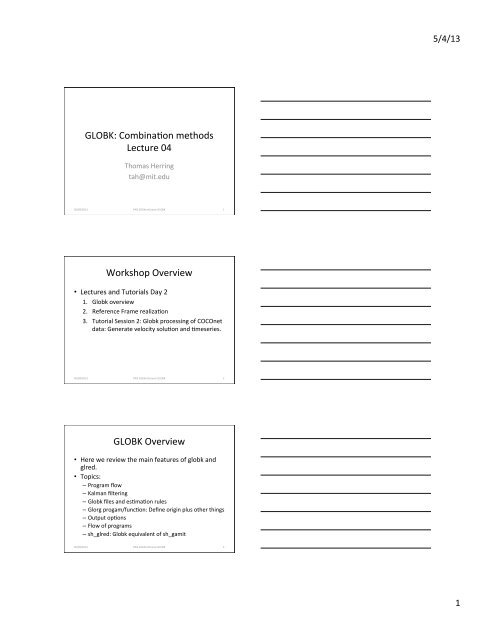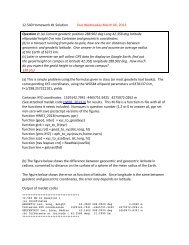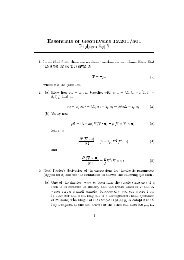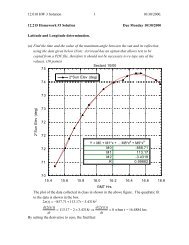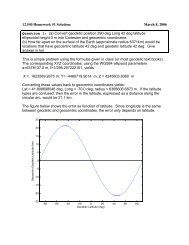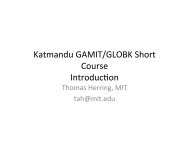GLOBK: Combina@on methods Lecture 04 Workshop Overview ...
GLOBK: Combina@on methods Lecture 04 Workshop Overview ...
GLOBK: Combina@on methods Lecture 04 Workshop Overview ...
Create successful ePaper yourself
Turn your PDF publications into a flip-book with our unique Google optimized e-Paper software.
<strong>GLOBK</strong>: Combina4on <strong>methods</strong><br />
<strong>Lecture</strong> <strong>04</strong><br />
Thomas Herring<br />
tah@mit.edu<br />
05/09/2013 PASI GGShortCourse <strong>GLOBK</strong> 1<br />
<strong>Workshop</strong> <strong>Overview</strong><br />
• <strong>Lecture</strong>s and Tutorials Day 2<br />
1. Globk overview<br />
2. Reference Frame realiza4on<br />
3. Tutorial Session 2: Globk processing of COCOnet<br />
data: Generate velocity solu4on and 4meseries.<br />
05/09/2013 PASI GGShortCourse <strong>GLOBK</strong> 2<br />
<strong>GLOBK</strong> <strong>Overview</strong><br />
• Here we review the main features of globk and<br />
glred.<br />
• Topics:<br />
– Program flow<br />
– Kalman filtering<br />
– Globk files and es4ma4on rules<br />
– Glorg progam/func4on: Define origin plus other things<br />
– Output op4ons<br />
– Flow of programs<br />
– sh_glred: Globk equivalent of sh_gamit<br />
05/09/2013 PASI GGShortCourse <strong>GLOBK</strong> 3<br />
5/4/13<br />
1
<strong>GLOBK</strong> Purpose<br />
• <strong>GLOBK</strong> is a suite of programs designed to combine geode4c results<br />
together. GPS phase processing can take a considerable 4me and <strong>GLOBK</strong><br />
provides a fast method for make large network solu4ons, combining many<br />
days to years of data together and studying alterna4ve parameteriza4on<br />
and reference frames for the veloci4es of sites.<br />
• <strong>GLOBK</strong> uses as data input, quasi-‐observa4on files called binary h-‐files<br />
which contain geode4c solu4ons with loosely constrained full covariance<br />
informa4on. These files can generated from gamit solu4ons or SINEX<br />
files.<br />
• <strong>GLOBK</strong> is a smoothing Kalman filter and can incorporate random walk<br />
process noise in its es4ma4on (method for accoun4ng for temporally<br />
correlated noise in 4me series).<br />
• Its two main uses are to generate velocity field es4mates and 4me series<br />
in a well-‐defined and o`en different reference frames. (It can also be<br />
used to merge large networks of GPS sites).<br />
05/09/2013 PASI GGShortCourse <strong>GLOBK</strong> 4<br />
Common applica4ons of <strong>GLOBK</strong><br />
• Repeatability analysis ( glred )<br />
– individual sessions<br />
– combine regional and global files for orbit control and<br />
reference frame (orbit control is not so important<br />
anymore; IGS orbits are very good apriori)<br />
• Combine sessions to get average posi4on over survey<br />
– connects sta4ons observed separately<br />
– reduces number of h-‐files to be used for veloci4es<br />
• Combine averaged posi4ons to es4mate veloci4es<br />
– and/or earthquake offsets and post-‐seismic mo4on<br />
05/09/2013 PASI GGShortCourse <strong>GLOBK</strong> 5<br />
<strong>GLOBK</strong> Func4on and File Flow<br />
htoglb: Translate GAMIT h-‐files to (e.g., hemeda.10256 ) to globk<br />
h-‐files (e.g. h1009131200_emed.glx<br />
[h-‐file list].gdl <br />
globk_comb.cmd<br />
Itrf08.apr<br />
IGS08_101117.eq<br />
comb.com <br />
glorg_comb.cmd<br />
itrf08.apr<br />
stab_site [list]<br />
G<br />
L<br />
O<br />
B<br />
K<br />
G<br />
L<br />
O<br />
R<br />
G<br />
globk_comb.prt<br />
globk_comb.log<br />
comb.com (binary solu4on file that<br />
can be used in glorg)<br />
globk_comb.org<br />
Names of files here can be chosen arbitrarily.<br />
05/09/2013 PASI GGShortCourse <strong>GLOBK</strong> 6<br />
5/4/13<br />
2
<strong>GLOBK</strong> file name conven4ons<br />
• <strong>GLOBK</strong> uses arbitrary file names but there are some<br />
conven4ons used:<br />
– Binary h-‐files from htoglb: .glx is bias fixed, .glr is bias free<br />
(normally not used)<br />
– List of binary h-‐files to process: .gdl extent<br />
– <strong>GLOBK</strong> and GLORG command files: globk_.cmd and<br />
glorg_.cmd.<br />
– Newer approach: Use the OPTION feature to allow different<br />
op4ons in the same command file.<br />
– Output files: print file (no glorg reference frame) .prt (o`en not<br />
output); glorg output .org; log file .log<br />
– Apriori coordinate files: .apr<br />
– Earthquake and rename file: .eq<br />
– Lists of stabiliza4on sites (used with source command): .stab<br />
05/09/2013 PASI GGShortCourse <strong>GLOBK</strong> 7<br />
Kalman Filtering<br />
• Equivalent to sequential least-squares estimation but allowing for<br />
stochastic processes, usually a 1st-order Gauss-Markov process<br />
• <strong>GLOBK</strong> allows a random walk for coordinates, EOP, network translation<br />
and scale, and satellite parameters; variance grows linearly with time<br />
• Because a Kalman filter works with covariance matrices (rather than<br />
normal matrices), all parameters must have a priori constraints (usually<br />
loose)<br />
See Herring et al. [1990] and Dong et al. [1998] for a more thorough<br />
description as applied to geodetic analysis<br />
05/09/2013 PASI GGShortCourse <strong>GLOBK</strong> 8<br />
<strong>GLOBK</strong> Structural Confusions<br />
• globk and glred are the same program with (slightly) different ways<br />
of trea4ng the h-‐file ( gdl ) list:<br />
– globk: all h-‐files in combined in a single solu4on<br />
– glred: each h-‐file generates a separate solu4on (unless followed by a<br />
+ ). glred is a small program that generates sub-‐set .gdl files and runs<br />
globk.<br />
• Two types of solu4on files:<br />
– h-‐files for saving and external exchange (backward compa4ble)<br />
– com/sol file is internal, format changes with versions<br />
• glorg called by globk/glred or run separately to apply<br />
generalized constraints to solu4on and es4mate plate rota4ons<br />
05/09/2013 PASI GGShortCourse <strong>GLOBK</strong> 9<br />
5/4/13<br />
3
<strong>GLOBK</strong> files<br />
• User supplied<br />
– command files (may include ‘source’ files)<br />
– gdl list of h-‐files<br />
– binary h-‐files (created from SINEX or GAMIT h-‐)<br />
– apr file(s) (op4onal but recommended)<br />
– EOP (in_pmu file, op4onal but recommended)<br />
– eq_file (op4onal, but must appear at top)<br />
• Generated by globk<br />
– srt, com, sol , svs (must be named and come first)<br />
• Output files<br />
– screen, log, prt, org and output h-‐file<br />
05/09/2013 PASI GGShortCourse <strong>GLOBK</strong> 10<br />
<strong>GLOBK</strong> file handling<br />
• log, prt, org files are concatenated, so should be<br />
removed or renamed unless you want them together<br />
(e.g. glred). The ‘eras’ op4on can be used in the<br />
prt_opt and org_opt command in the globk command<br />
file to erase these files (should not be used with glred).<br />
• com, srt, sol files are overwriqen; com/sol should not<br />
be renamed since the original sol file name is<br />
imbedded in the com file<br />
• Automa4c naming using wild-‐cards is available for<br />
com, srt, sol, org, and output h-‐files (i.e., name used<br />
depends on name of .gdl file; needed for parallel<br />
processing.)<br />
05/09/2013 PASI GGShortCourse <strong>GLOBK</strong> 11<br />
Es4ma4on commands rules<br />
• For a parameter to es4mated in globk, apr_xxx command must be<br />
used where xxx is a parameter type (e.g., neu, svs, wob, ut1, atm)<br />
• If a parameter is not men4oned, it does not appear in the solu4on,<br />
but if it appears in the h-‐file (i.e, es4mated in GAMIT), its<br />
uncertainty is implicit in the globk solu4on; e.g., if orbits are<br />
es4mated in GAMIT and you want them constrained in globk, use<br />
apr_svs. If apr_svs is not used, orbits are le` constrained.<br />
• If zero given as a priori sigma, then parameter is not es4mated<br />
(effec4vely le` unconstrained)<br />
• To force a parameter to it’s a priori value, use F as the a priori<br />
sigma<br />
• Parameters es4mated in glorg must be kept loose in globk ; if<br />
rota4on or scale is not es4mated in glorg, it must be 4ghtly<br />
constrained in globk<br />
05/09/2013 PASI GGShortCourse <strong>GLOBK</strong> 12<br />
5/4/13<br />
4
Earth Orienta4on Parameters ( EOP )<br />
• Most processing is now done in GAMIT BASELINE mode<br />
(sestbl.) which fixes the orbits and does not es4mates EOPs<br />
in GAMIT. In globk, it is always best to es4mate EOPs to<br />
allow the local network processing to rotate to align to the<br />
chosen reference frame.<br />
• Two forms of EOP es4ma4on can be used<br />
– Conven4onal wobble and UT1 es4mates<br />
• apr_wob 100 100 0 0 ! XY pole posi4on and rate mas,mas/yr<br />
• apr_ut1 100 0 ! UT1 offset and rate (mas and mas/yr)<br />
– Alterna4ve (useful if mixed data processing)<br />
• apr_rot 100 100 100 0 0 0 ! All rota4on angles and rates (mas, mas/<br />
yr)<br />
• When glorg is used (recommended) one of two forms<br />
should used (especially if changing from IGS08 to local<br />
reference frame)<br />
05/09/2013 PASI GGShortCourse <strong>GLOBK</strong> 13<br />
Data Edi4ng<br />
• To account for temporal correla4ons in 4me series we typically use<br />
random-‐walk (RW) process noise with the mar_neu command (units m2/<br />
yr )<br />
• Typical values are 2.5E-‐8 (0.5 mm in 1 yr) to 4E-‐6 (2 mm in 1 yr)<br />
mar_neu all 2.5E-‐8 2.5E-‐8 2.5E8 0 0 0<br />
mar_neu chdu 4E-‐6 4E-‐6 4e-‐6 0 0 0<br />
• The sh_gen_stats script can used to generate process noise es4mates<br />
provided sufficiently large number of posi4on es4mates are available.<br />
• To down-‐weight noisy segments or equalize con4nuous and survey-‐mode<br />
data in a combined h-‐file, can add random noise (units are m)<br />
sig_neu all .001 .001 .003<br />
sig_neu ankr .005 .005 .020 2002 10 1 0 0 2002 11 30 24 0<br />
sig_neu EMED05<strong>04</strong> .010 .010 .1<br />
• To remove an outlier, can down-‐weight severely or rename<br />
sig_neu ankr .1 .1 .1 2002 10 1 0 0 2002 10 1 24 0<br />
rename ankr_gps ankr_xcl 2002 10 1 0 0 2002 10 1 24 0 ( eq_file )<br />
05/09/2013 PASI GGShortCourse <strong>GLOBK</strong> 14<br />
GLORG<br />
• Invoked by globk to apply generalized constraints<br />
a`er h-‐files are stacked and loose solu4on<br />
performed; can be run as a separate program<br />
using the com/sol files from globk<br />
• Also allows linking of parameters and es4ma4on<br />
of Euler poles<br />
• Parameters es4mated in glorg must be kept loose<br />
in globk (coordinates, EOP, scale)<br />
• GLORG is used to define and refine the reference<br />
frame for <strong>GLOBK</strong> solu4ons.<br />
05/09/2013 PASI GGShortCourse <strong>GLOBK</strong> 15<br />
5/4/13<br />
5
Invoking GLORG from globk command file<br />
• The globk command file contains commands that<br />
cause glorg to run when globk completes the<br />
solu4on combina4on:<br />
– org_cmd < glorg command file name > -‐-‐-‐invokes<br />
glorg<br />
– org_opt < op4ons for output ><br />
– org_out < output file name >: Normally not used<br />
because name will be generated from prt file name in<br />
the globk runstring.<br />
• If org_out is not given then the extent on the<br />
print file name is replaced with org<br />
05/09/2013 PASI GGShortCourse <strong>GLOBK</strong> 16<br />
GLORG Commands<br />
• apr_file – Need not be the same as for globk; needs to contain<br />
values only for sites used for stabiliza4on and sites for which<br />
coordinates or veloci4es are equated<br />
• pos_org, rate_org – Control what parameters are es4mated in<br />
stabiliza4on<br />
– xtran ytran ztran – allows transla4on<br />
– xrot yrot zrot – allows rota4on<br />
– scale – allows rescaling of system (if used, es4mate scale in globk;<br />
apr_scale and possibly mar_scale)<br />
• cnd_hgtv – Control rela4ve weights of heights (variances, nominally<br />
10 but increasing value will reduce heights effec4ng horizontal<br />
posi4on es4mates; 1000 is good for this)<br />
• stab_ite – # of itera4ons and sigma-‐cutoff to remove a site<br />
• stab_site – List of sites to use in stabiliza4on<br />
05/09/2013 PASI GGShortCourse <strong>GLOBK</strong> 17<br />
Controlling Print Output<br />
• crt_opt, prt_opt, org_opt specify output op4ons for screen, print and org<br />
files<br />
• globk/glorg help gives all op4ons, main ones are:<br />
– ERAS -‐-‐ erase file before wri4ng (normally files appended)<br />
– NOPR -‐-‐ Do not write output ( e.g., for globk when invoking glorg )<br />
– BLEN -‐-‐ Baseline lengths<br />
– BRAT -‐-‐ baseline rates when veloci4es es4mated<br />
– RNRP -‐-‐ generates reports on differences in parameter es4mates a`er<br />
renames.<br />
– FIXA -‐-‐ makes apriori coordinates and veloci4es consistent when equates are<br />
used in glorg (can some4mes fail in complicated rename scenarios-‐-‐best if<br />
apr_file is provided with consistent values)<br />
– VSUM -‐-‐ Lat/long summary of velocity (needed to plot veloci4es)<br />
– PSUM -‐-‐ Lat/long posi4on summary<br />
– GDLF -‐-‐Include list of hfiles and chi**2 increments from run<br />
– CMDS -‐-‐ Echos globk command file into output file<br />
05/09/2013 PASI GGShortCourse <strong>GLOBK</strong> 18<br />
5/4/13<br />
6
Handling Steps due to Earthquakes (or<br />
instrument changes)<br />
• Level 1 ( always necessary )<br />
Rename the site, either automa4cally (e.g. Wenchuan, May 2008)<br />
<br />
eq_def WC 31.099 103.279 1000 20 2008 5 12 6 28<br />
eq_rename WC forces rename, e.g. CHDU_GPS -‐-‐> CHDU_GWC<br />
eq_cosei to specify spa4ally dependent constraints on posi4on adjustments<br />
• or explicitly (for non-‐tectonic steps)<br />
rename iisc_gps iisc_1ps 1995 10 1 2 0 0 1999 12 1 5 0<br />
! Antenna swap from Trimble SST to AOA choke ring<br />
rename lake_gps lake_xhi 2002 1 12 0 0 2002 1 12 24 0<br />
• Commands put in the eq_file (not globk command file)<br />
• Effect is to make the site’s coordinates and veloci4es independent in the solu4on<br />
• The script sh_makeeqdef can be used to generate an eq defini4on file bases on the<br />
NEIDC seismic catalog and program s4nf_to_rename can used to generate<br />
renames due to antenna changes.<br />
05/09/2013 PASI GGShortCourse <strong>GLOBK</strong> 19<br />
Handling Steps due to Earthquakes (or<br />
instrument changes)<br />
• Level 2 ( almost always desirable )<br />
• In glorg equate the veloci4es, either explicitly<br />
equate iisc_gps ndot iisc_1ps ndot<br />
equate iisc_gps edot iisc_1ps edot<br />
equate iisc_gps udot iisc_1ps udot<br />
• or automa4cally<br />
eq_dist 1000 ndot<br />
eq_dist 1000 edot<br />
eq_dist 1000 udot<br />
unequate chdu_gps ndot chdu_gwc ndot<br />
unequate chdu_gps edot chdu_gwc edot<br />
unequate chdu_gps udot chdu_gwc udot<br />
• Effect is to (re)link the adjustment (should be used with the FIXA op4on)<br />
• Can create a so` link with “constrain” command (so that values are not forced to<br />
be exactly the same.<br />
• Equates are applied to adjustments to apriori coordinates, so in general these<br />
should be the same (FIXA op4on will o`en do this automa4cally; unify_apr is<br />
another method).<br />
05/09/2013 PASI GGShortCourse <strong>GLOBK</strong> 20<br />
Handling Steps due to Earthquakes (or<br />
instrument changes)<br />
• Level 3 ( o9en useful to improve far-‐field veloci?es )<br />
• Equate the posi4ons when a site within the EQ radius has a<br />
small displacement<br />
equate xian_gps npos xian_gwc npos<br />
equate xian_gps epos xian_gwc epos<br />
equate xian_gps upos xian_gwc upos<br />
• May be used in conjunc4on with a model, applied as an<br />
offset in a rename command (need to be very careful with<br />
approach or offsets can applied mul4ple 4mes).<br />
rename xian_gwc xian_gwc 2008 5 12 6 28 -‐0.003 0.0<strong>04</strong> 0.001 NEU<br />
• Offse}ng the coordinates in the globk apr_file<br />
05/09/2013 PASI GGShortCourse <strong>GLOBK</strong> 21<br />
5/4/13<br />
7
Program Flow<br />
• Read all the h-‐file headers to determine their contents ( sites, other<br />
parameters, epoch range)<br />
• Apply renames as requested in the eq_file<br />
• Sort the h-‐file list forward or backward in 4me ( srt_dir )<br />
• Ini4alize the Kalman filter with the a priori constraints ( apr_xxx )<br />
• Read in the h-‐files, one at a 4me, compute the chi2 increment, coordinate<br />
adjustment, and rota4on implied by the new data; if within tolerance<br />
(max_chii ), update the solu4on and write the chi2 increment to the log<br />
file<br />
• Write the solu4on to the sol_file and prt file (and op4onally to a new h-‐<br />
file)<br />
• Op4onally invoke glorg to apply generalized constraints<br />
– Apply the constraints ( itera4ve “stabiliza4on” )<br />
– Apply linkage of parameters ( equate, constrain, force ), compu4ng the chi2<br />
increment for each<br />
– Es4mate plate rota4ons ( plate command )<br />
– Write the solu4on to the org file ( glorg prt file )<br />
05/09/2013 PASI GGShortCourse <strong>GLOBK</strong> 22<br />
Things <strong>GLOBK</strong> cannot do<br />
• Repair mistakes in original analysis<br />
– cycle slips<br />
– wrong antenna phase center models<br />
• Resolve ambigui4es<br />
– (would make files too large)<br />
• Overcome non-‐linear effects<br />
– As in GAMIT, adjustments must be less than ~ 30 cm<br />
• But <strong>GLOBK</strong> can delete sta4ons<br />
– can help avoid contamina4ng solu4on<br />
05/09/2013 PASI GGShortCourse <strong>GLOBK</strong> 23<br />
Apr Files in <strong>GLOBK</strong> Processing<br />
• GAMIT<br />
– 10 m accuracy for all sites for cycle-‐slip repair<br />
– < 30 cm final adjustment for linearity (1st solu4on guarantees)<br />
– ~5 cm accuracy in constrained site(s) for ambiguity resolu4on<br />
• globk<br />
– If invoking glorg for reference frame, apr_file usually op4onal in<br />
globk<br />
– If not invoking glorg, need accurate apr_file entries for<br />
constrained sites<br />
– For complicated renames and equates, apr_file may be needed<br />
in globk<br />
• glorg<br />
– Apr_file needs coodinates only for reference sites and equates<br />
05/09/2013 PASI GGShortCourse <strong>GLOBK</strong> 24<br />
5/4/13<br />
8
What can go wrong ?<br />
• globk<br />
– H-‐files not used: removed automa4cally for high chi2, coordinate<br />
adjustment, or rota4on ( max_chii command )<br />
– High chi2 increment: inconsistent data<br />
– Sta4on “missing”: not present in h-‐file or renamed out ( use glist )<br />
• glorg<br />
– Stabiliza4on fails: too-‐few sites in stabiliza4on<br />
– Large uncertain4es: poor stabiliza4on<br />
– Too-‐small uncertain4es for some stabiliza4on sites: rota4on<br />
parameters absorbing coordinate adjustment<br />
– High chi2 in equate: inconsistent data<br />
– Wrong velocity for equated sites: unmatched apriori<br />
05/09/2013 PASI GGShortCourse <strong>GLOBK</strong> 25<br />
Associated programs<br />
– htoglb – Translates various ascii solu4on files into<br />
<strong>GLOBK</strong> h-‐files (GAMIT h-‐files, SINEX)<br />
– glbtosnx -‐-‐ Generates SINEX files from binary h-‐files<br />
– glist -‐-‐ lists the contents of a series of h-‐files<br />
– hfupd -‐-‐ Updates binary h-‐files for changes in<br />
sta4on.info or sinex header file (distributed by IGS)<br />
– ensum, enfit, tscon, tsfit -‐-‐ 4me series analysis (batch)<br />
• Matlab derived programs (interac4ve):<br />
– velview -‐-‐ displays and analyzes velocity fields<br />
– tsview -‐-‐ displays and analyses 4me series.<br />
05/09/2013 PASI GGShortCourse <strong>GLOBK</strong> 26<br />
sh_glred script<br />
• A convenient way to run globk/glorg to generate 4me series:<br />
sh_glred –s 2011 256 2011 303 -‐opt H G E<br />
• Requires user-‐constructed command files in /gsoln<br />
(globk_comb.cmd and glorg_comb.cmd : eq_file, apr_file, use_site<br />
list, stab_s4e list, .. ) Copy templates from gg/tables and edit for<br />
your network.<br />
• Automa4cally creates one gdl file per day (unlike glred when run<br />
directly, which may have a single gdl file with h-‐files for many days<br />
• With the ‘E’ op4on, will invoke sh_plotcrd (calling ‘ensum’) to<br />
extract coordintes from the org files and plot them.<br />
• Addi4onal op4ons allow automa4c download of global h-‐files from<br />
MIT or SOPAC and combina4on with the local h-‐files<br />
05/09/2013 PASI GGShortCourse <strong>GLOBK</strong> 27<br />
5/4/13<br />
9
Suggested Directory Structure for<br />
Mul4-‐year Processing<br />
/project<br />
/YYY1 /YYY2 . . . /vsoln /tables<br />
/tables /gsoln /DDD . . .<br />
Notes<br />
• Experiment/project directory names do not have to match the sh_gamit 4-‐<br />
character expt name<br />
• Experiment-‐wide tables ( e.g. apr, eq/rename, use_site, edit files ) may<br />
reside in top-‐level or yearly /tables (just get the path right in the globk/<br />
glorg command files)<br />
• Can add mul4ple ‘solu4on’ directories at the top level for different analyses<br />
• Copy templates for globk_vel.cmd and glorg_vel.cmd from gg/tables to /<br />
vsoln and edit<br />
• Generate h-‐file list in /vsoln using, .e.g. ‘ ls YYY?/gsoln/h*glx > project.gdl ‘<br />
05/09/2013 PASI GGShortCourse <strong>GLOBK</strong> 28<br />
Steps in Mul4-‐year Analysis<br />
• Generate daily 4me series for each year or par4al year using sh_glred ;<br />
create edit commands as appropriate (sig_neu and/or xcl renames)<br />
• Op4onally aggregate the days into weekly, monthly, or survey-‐length H-‐<br />
files using sh_glred with the –ncomb op4on and out_glb specified in<br />
globk_comb.cmd.<br />
• Generate a mul4-‐year 4me series using glred/glorg and sh_plotcrd;<br />
repeat with reweigh4ng<br />
• Perform a velocity solu4on using globk/glorg; plot with sh_plotvel<br />
• Extract a new stabiliza4on apr file from the velocity solu4on<br />
• Repeat the mul4-‐year 4me series using the new apr file and a stab_site list<br />
expanded to include all well-‐determined CGPS and SGPS sites<br />
• Note: It may be convenient to use the ‘source’ op4on in globk_comb.cmd<br />
and globk_vel.cmd to include use_site, stab_site, and sig_neu lists (see<br />
templates)<br />
05/09/2013 PASI GGShortCourse <strong>GLOBK</strong> 29<br />
<strong>GLOBK</strong> Commands for Mul4-‐year<br />
Solu4ons<br />
In /voln directory:<br />
• Repeatabili4es<br />
glred 6 globk.comb.prt globk.comb.log project.gdl<br />
globk_comb.cmd<br />
sh_plotcrd –f globk_comb.org –s long<br />
• Veloci4es<br />
globk 6 globk_vel.prt globk_vel.log project.gdl globk_vel.cmd<br />
sh_plotvel -‐f globk_vel.org -‐R244.5/25140.5/46.5<br />
05/09/2013 PASI GGShortCourse <strong>GLOBK</strong> 30<br />
5/4/13<br />
10
Eq_file entry for Maule earthquake<br />
• EQ_DEF M 8.8<br />
eq_def MA -‐36.030 -‐72.850 3539.0 26.0 2010 2 27 6 34 190.4683<br />
eq_rename MA<br />
eq_coseis MA 0.001 0.001 0.001 190.468 190.468 190.468<br />
eq_log MA 1.0 0.001 0.001 0.001 190.468 190.468 190.468<br />
05/09/2013 PASI GGShortCourse <strong>GLOBK</strong> 31<br />
ITRF2008_comb<br />
• On the chandler.mit.edu `p incremental_updates<br />
site, the tables directories contains the latest files<br />
itrf2008 files:<br />
– itrf2008_comb.apr : Combined IGS coordinate file<br />
updated as new sites are added (also comes in<br />
different plate versions)<br />
– itrf2008_comb.eq : Rename file that goes with apriori<br />
file to account for 4me series offsets. Linking this file<br />
to eq_renames in tables directory for gamit<br />
processing will generate correct site coordinates.<br />
05/09/2013 PASI GGShortCourse <strong>GLOBK</strong> 32<br />
Convenient Methods of Crea4ng Edit Commands<br />
To eliminate a data point (sta4on/epoch), you can put into the eq_file commands of the<br />
form<br />
rename areq areq_xcl 2009 3 5 0 0 2009 3 5 24 0<br />
which you can create with a specified sigma-‐cutoff in tsview (interac4ve) or tsfit (batch); you<br />
can also create the commands with a mouse click in tsview<br />
To downweight horizontal and/or ver4cal data points (sta4on/epoch), you can put into the<br />
globk command file (perhaps using ‘source daily.reweights’) commands of the form<br />
sig_neu areq 0.010 .010 .100 2009 3 5 0 0 2009 3 5 24 0<br />
which you can create with a few keystrokes by using program grw<br />
grw areq 09 64 64 10 100<br />
(day 64 is 5 March; units here are mm, but m in sig_neu)<br />
( ‘grw’ stands for ‘globk reweight’ and is easy to type . It appends to a file temp.out )<br />
NOTE: If you are referencing a combined h-‐file (more than 1 day), the date range given for<br />
the rename or sig_neu command must encompass the range of the h-‐file<br />
05/09/2013 PASI GGShortCourse <strong>GLOBK</strong> 33<br />
5/4/13<br />
11
Summary<br />
• <strong>GLOBK</strong> has many features and due to its evolu4on, there<br />
are o`en mul4ple ways of doing the same or similar things.<br />
• There is extensive help in the ~/gg/help/ directory and<br />
discussion in the documenta4on.<br />
• <strong>GLOBK</strong> is where all the major analysis decisions are made<br />
and hence can be quite complex for large analyses.<br />
• Experimenta4on and tes4ng your ideas of how different<br />
op4ons effect the results is one the best ways to learn the<br />
so`ware (e.g., what happens to posi4on/velocity es4mates<br />
if the apr_tran command is added to the globk command<br />
file? How do my es4mates and uncertain4es change if the<br />
apr_neu and mar_neu commands are changed?<br />
05/09/2013 PASI GGShortCourse <strong>GLOBK</strong> 34<br />
5/4/13<br />
12


